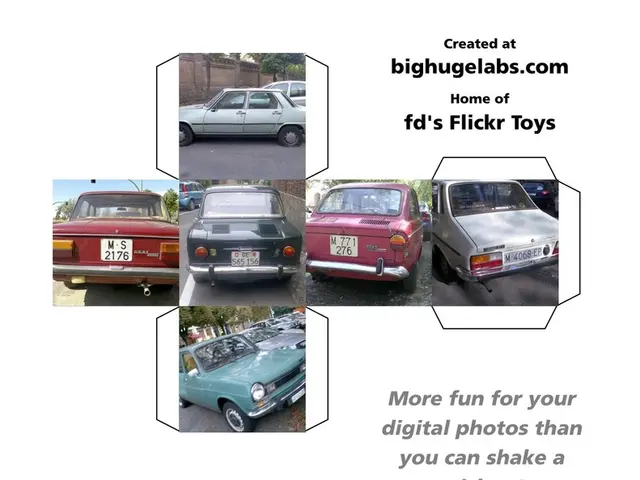Sensing Magnetic Fields: Paving the Way for Future Electronics and Robotics Developments
Navigating the Magnetic Frontier: Magnetic Field Sensing in Digital Age Robotics
Delve into the fascinating world of magnetic field sensing, a technology essential for the next wave of electronics and robotics. This technology enables the precise measurement and detection of magnetic fields, advancing fields as varied as consumer electronics, healthcare, and aerospace.
What's All the Fuss About Magnetic Field Sensing?
The impact of magnetic field sensing lies in its ability to offer reliable, precise signals for navigation, positioning, and control. By understanding the fundamentals of this tech, we can appreciate its vast applications in the digital age.
Contact & Conversion: The Core of Magnetic Interplay
Magnetic field sensing relies on the interaction between a sensor and a magnetic field, resulting in a voltage change or state shift in the sensor. This interaction comes down to basic physics, with the right-hand rule and Lorentz force equation guiding the way.
Decoding the Magnetic Code: Sensors of Choice
Diverse magnetic field sensors cater to distinct applications, with options ranging from Fluxgate sensors to Anisotropic Magneto Resistance (AMR) sensors:
- Fluxgate sensors: Ideal for low-frequency and low field measurements
- Hall effect detectors: Suitable for linear and digital applications, and capable of speedy response times
- Magneto-Inductive (MI) sensors: Non-contact sensors used for sensing through metal obstacles
- GMR sensors: Known for their high sensitivity and signal-to-noise ratio
- AMR sensors: Renowned for their linearity and durability, making them suitable for consumer and automotive applications
A Magnetic Marvel: Applications in Action
The reach of magnetic field sensing is wide and growing, with key usages embracing robotics, automotive systems, and healthcare:
- Robotics & Mechatronics: Magnetic field sensing empowers robots to navigate and manipulate their surroundings with precision.
- Automotive Electronics: Applications like anti-lock braking systems, electronic stability control, and navigation rely on magnetic field sensing for control and positioning.
- Healthcare: Magnetic field sensors grace the inner workings of medical devices, from MRI machines to magnetic therapy devices.
Evading Obstacles in the Magnetic Landscape
Despite its many advantages, magnetic field sensing encounters several hurdles:
- Interference: External magnetic disturbances can affect sensor accuracy
- Calibration & Alignment Woes: Correct sensor orientation and alignment are crucial for optimal performance
- Sensor Fouling: Deterioration or contamination of sensors can compromise their effectiveness
- Noise & Temperature Effects: Limitations in temperature tolerance and sensitivity to external disturbances may pose challenges
Pushing the Magnetic Boundaries: Future Advancements
State-of-the-art research and development strive to overcome the challenges in magnetic field sensing and unlock new possibilities:
- Revolutionizing Sensor Materials: Innovation in materials strengthens sensor performance and versatility
- AI & Machine Learning Fusion: Integrating machine learning algorithms can optimize sensor functionality, improving sensitivity and signal quality
- Smaller, More Power-Efficient Designs: Miniaturizing sensors to fit a variety of applications while preserving low power consumption
Worlds Collide: Magnetic Feats in Modern Applications
Real-world examples showcase the prowess of magnetic field sensing:
- Warehousing Marvels: Autonomous forklifts utilize magnetic field sensors for accurate navigation and improved productivity
- Fine-tuned Assemblies: Engineered robot arms exploit magnetic field sensing for precise object manipulation and intricate assembly tasks
Conclusion
Magnetic field sensing is an indispensable technology, driving innovation in a multitude of domains. As researchers and developers continue to chisel the boundaries, we can expect an unfolding tale of more accurate, reliable, and efficient solutions for an array of industries. Embrace the magnetic revolution as we embark upon a dazzlingly digital, sensored future!
Q & A with a Magnetic Field Sensing Whiz
- Q: What're the challenges linked to magnetic field sensing in robotics?A: Challenges include external magnetic interference, sensor calibration and alignment issues, sensor contamination or damage, and noise and temperature effects.
- Q: Magnetic field sensing: What's the big deal?A: Magnetic field sensing grants us high accuracy and precision, robustness and reliability, compact and lightweight design, low power consumption, and cost-effectiveness – all vital for cutting-edge robotics.
- Q: How does magnetic field sensing facilitate robotics in action?A: In robotics, magnetic field sensing provides positioning, navigation, and manipulation capabilities, empowering robots to interact seamlessly with their environments.
- Q: Where does magnetic field sensing head in the future?A: Progress in sensor materials, AI integration, design simplification, and sensitivity enhancement will continue shaping the landscape of magnetic field sensing.
- In the digital age, magnetic field sensing has proven essential for various industries, including robotics, as it allows for precise navigation, positioning, and manipulation.
- By pushing the boundaries of sensor materials and integrating AI and machine learning, researchers aim to overcome challenges in magnetic field sensing and enable even more accurate and efficient solutions for real-world applications.




